Предмет: Қазақ тiлi,
автор: nurbekalua30
задание:Кестенi пайдаланып, косымшаны дурыс жалгап айт
Приложения:

Ответы
Автор ответа:
1
Ответ:
сізге тамақ пісірДІ. Үйіңізді жинап берДі.
Ол бұлақты тазалаДы. Сіздер үйлеріңызді тазалаДыңыздар.
Объяснение:
дальше былмим ойткены кесте жок(
Автор ответа:
0
Ответ:
1.Пісірді
2.берді
3.тазалады
4.жүрдік
5.келдіңдер
6.тазаладыңыздар
7.бердім
8.Істедім
9.пісірдістер
10.байлаймыз
11.Жинады
Похожие вопросы
Предмет: Английский язык,
автор: ivanovamiss19
Предмет: Русский язык,
автор: basab5977
Предмет: Английский язык,
автор: milashka3991
Предмет: Математика,
автор: Droids
Предмет: Математика,
автор: Lil3111